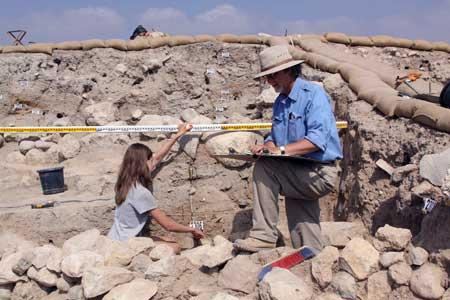Seminary professor's discovery might add truth to Biblical tale
Matthew Santoni
Source - http://www.pittsburghlive.com/x/pittsburghtrib/news/s_776135.html
Amid the rolling hills and olive groves of what used to be the frontier between ancient Judah and the neighboring Philistines, Ron Tappy and his team discovered a 38-pound block of limestone faintly inscribed with the Hebrew equivalent of someone's ABCs.
Tappy, the G. Albert Shoemaker Professor of Bible and Archaeology at the Pittsburgh Theological Seminary in East Liberty, will discuss that 2005 discovery -- and how it could add some truth to biblical accounts of the kingdoms of David and Solomon -- Wednesday with the Historical Society of Mt. Lebanon.

Since 1999, Tappy has been making regular archeological expeditions to an area called Tel Zayit, which used to be a small, but strategically located, town on the border between the Israelites and the Philistines. Digging up the rough limestone foundation of a building dated to about the 10th century B.C., his expedition found a near-complete Hebrew alphabet carved into one of the stones.
Scholarly opinions differ on whether the carving was a teaching tool like the ABCs in a modern classroom, a doodle by a scribe practicing his writing, or an inscription of the alphabet, which was believed to have magical or mystical protective powers in an era when literacy was rare, Tappy said.
His own interpretation -- that it was intended as a protective inscription, perhaps aimed toward the nearby border -- lead Tappy to believe that at least one inhabitant of the Iron-Age town was literate, and that suggested there were others like him in Jerusalem.
"He's out in the boondocks... We have to assume there are learned scribes in Judah who can do better. We just haven't found them," Tappy said.
Scholars disagree over whether there were actually kingdoms of Israel or Judah in the 10th century B.C., or whether they were scattered tribal areas and the kingdoms were invented by the writers of the Old Testament centuries later. Tappy said the stone and other evidence at the Tel Zayit site suggest to him that there was a kingdom of Judah ruled from Jerusalem 3,000 years ago, though it was likely not as powerful and wealthy as it is in biblical accounts.
"I don't think any archaeologist today thinks Jerusalem was as large or as grand or as covered in gold as the biblical portrayal," he said. "You can admit that without saying what they wrote was entirely false and nothing was there."